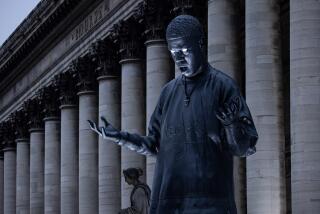Sculptor Sends His Latest Work on European Cruise
- Share via
George Baker is having trouble. The 56-year-old Occidental College professor is standing near his latest work, a 20-foot-long kinetic sculpture made of stainless steel, trying to explain his original intent.
“I really can’t say that I started out with a specific image or specific anything other than allowing a composition of forms that also move to evolve,” Baker said. “I had to decide on how big it would be and, in making that decision, the shapes themselves just started happening.”
But if Baker isn’t sure where this latest work came from, he knows where it’s going. This week, the sculpture, titled “Suspended Forms,” will be dismantled and flown to St. Nazaire, France, where it will be reassembled and hung in the nine-deck-high atrium of a Sitmar Cruises ship.
Sitmar commissioned the piece as part of a $1-million effort to establish a museum-class collection of original art for permanent display aboard its newest ship, the Star Princess.
Charles Mitchell, the Los Angeles art consultant that Sitmar hired to assemble the collection, said the company plans to acquire 80 pieces, all by respected artists, for display in ships’ public spaces.
Mitchell said he selected Baker to create the centerpiece of the collection because the “kinetic movements of his work give me the same feeling as being aboard a ship, and the texture he gives the stainless steel is similar to the way water reflects light.”
Baker, whose work has been exhibited around the world, including the Museum of Modern Art and Whitney Museum of American Art in New York, became interested in art while a student at Occidental, a school he has never been very far from. Although he dropped out and enlisted in the Navy in 1952, Baker was persuaded by his mother to return to school in 1956 to study art. He graduated in 1958 and went on to earn a master of fine arts degree from USC.
Baker returned again to Occidental as an art teacher in 1964, the same year his artistic curiosity led him to experiment with kinetic sculpture.
“I finished this piece, and I somehow wanted to look at the other side without going around to the other side,” he said. He did not know anything about kinetic sculpture and knew of no one to ask, so he “just bumbled around for a while. I actually mounted that first one on a ball bearing so that when you touched it, it turned.”
Sources of Energy
Since then, Baker has focused almost exclusively on kinetic pieces. Some, like a large floating sculpture commissioned in 1976 by the state of Nebraska for a man-made lake in Kearney, are powered only by wind. Others, like “Suspended Forms,” are powered by small remote-controlled motors.
Although most of his works end up as large steel sculptures, they begin as trophy-sized models, or maquettes. Baker makes the maquettes out of paper and cardboard to convey his concept to his assistant, Eric Pultzer, who is responsible for engineering it. Pultzer calculates the structural specifications, which then must be approved by a consulting engineer.
“Eric’s job is to figure out how to make the sculpture without making me unhappy visually,” Baker said.
Heavy Steel Piece
In the case of “Suspended Forms,” that meant modifying a steel I-beam so that it could be concealed within the core of the sculpture and finding a way to inconspicuously tether the piece with guy wire to several points in the atrium.
In addition to Pultzer, Baker usually employs four or five other assistants, often Occidental art students, who assemble the sculpture. It’s a system that Pultzer says is common, but one that is usually hard for people to understand.
“It’s the way a lot of artists work,” he said. “It’s the way all architects work; they don’t go out and sling mud and put up 2-by-4s. It’s kind of like a composer setting notes to music. George will make up a lot of shapes and just sort of mix and match. He has thousands of shapes on his workroom table. He knows what they all are, and he’ll sort of adjust them and compose.”
In early November, Baker and Pultzer will fly to France to be aboard the Star Princess when the ship goes through sea trials. When they return, they will be finishing work on Baker’s latest creation, a large kinetic fountain that will be placed in front of the World Trade Center under construction in Long Beach.
More to Read
The biggest entertainment stories
Get our big stories about Hollywood, film, television, music, arts, culture and more right in your inbox as soon as they publish.
You may occasionally receive promotional content from the Los Angeles Times.










